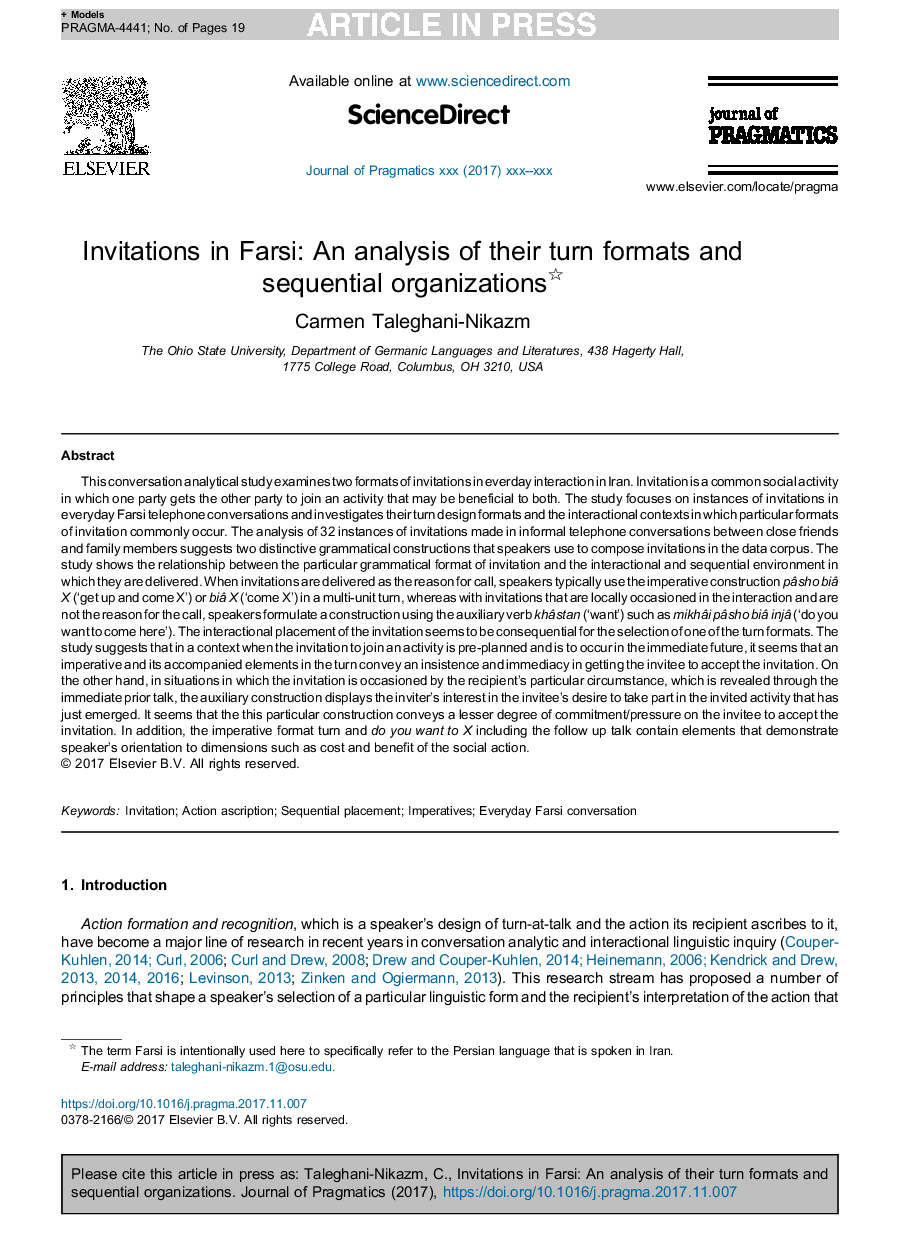| کد مقاله | کد نشریه | سال انتشار | مقاله انگلیسی | نسخه تمام متن |
|---|---|---|---|---|
| 7297532 | 1474675 | 2018 | 19 صفحه PDF | دانلود رایگان |
عنوان انگلیسی مقاله ISI
Invitations in Farsi: An analysis of their turn formats and sequential organizations
ترجمه فارسی عنوان
دعوت نامه های فارسی: تجزیه و تحلیل فرایندهای نوبت خود و سازمان های متوالی
دانلود مقاله + سفارش ترجمه
دانلود مقاله ISI انگلیسی
رایگان برای ایرانیان
کلمات کلیدی
دعوت نامه، اقدام عملی قرار دادن پیوسته، امپراتوری، گفتگو روزمره فارس،
موضوعات مرتبط
علوم انسانی و اجتماعی
علوم انسانی و هنر
زبان و زبان شناسی
چکیده انگلیسی
This conversation analytical study examines two formats of invitations in everday interaction in Iran. Invitation is a common social activity in which one party gets the other party to join an activity that may be beneficial to both. The study focuses on instances of invitations in everyday Farsi telephone conversations and investigates their turn design formats and the interactional contexts in which particular formats of invitation commonly occur. The analysis of 32 instances of invitations made in informal telephone conversations between close friends and family members suggests two distinctive grammatical constructions that speakers use to compose invitations in the data corpus. The study shows the relationship between the particular grammatical format of invitation and the interactional and sequential environment in which they are delivered. When invitations are delivered as the reason for call, speakers typically use the imperative construction pâsho biâ X ('get up and come X') or biâ X ('come X') in a multi-unit turn, whereas with invitations that are locally occasioned in the interaction and are not the reason for the call, speakers formulate a construction using the auxiliary verb khâstan ('want') such as mikhâi pâsho biâ injâ ('do you want to come here'). The interactional placement of the invitation seems to be consequential for the selection of one of the turn formats. The study suggests that in a context when the invitation to join an activity is pre-planned and is to occur in the immediate future, it seems that an imperative and its accompanied elements in the turn convey an insistence and immediacy in getting the invitee to accept the invitation. On the other hand, in situations in which the invitation is occasioned by the recipient's particular circumstance, which is revealed through the immediate prior talk, the auxiliary construction displays the inviter's interest in the invitee's desire to take part in the invited activity that has just emerged. It seems that the this particular construction conveys a lesser degree of commitment/pressure on the invitee to accept the invitation. In addition, the imperative format turn and do you want to X including the follow up talk contain elements that demonstrate speaker's orientation to dimensions such as cost and benefit of the social action.
ناشر
Database: Elsevier - ScienceDirect (ساینس دایرکت)
Journal: Journal of Pragmatics - Volume 125, February 2018, Pages 111-129
Journal: Journal of Pragmatics - Volume 125, February 2018, Pages 111-129
نویسندگان
Carmen Taleghani-Nikazm,
